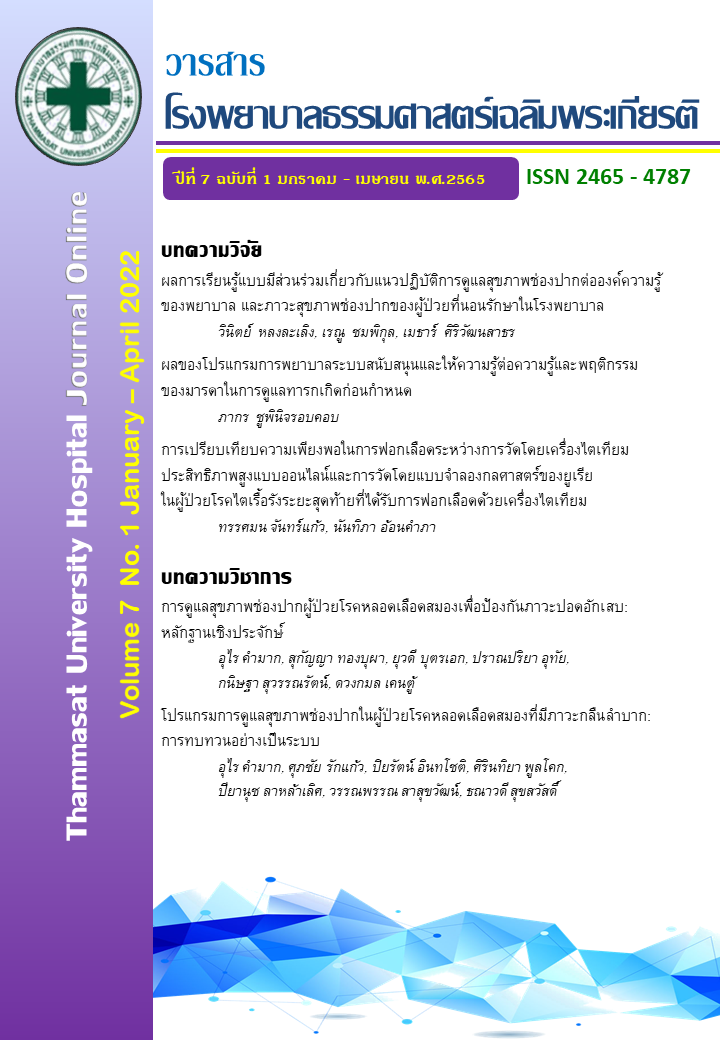Oral health care program in Dysphagia in stroke patients: A Systematic Review
Keywords:
Oral care program, Mouth care, Stroke patientsAbstract
Introduction: Stroke survivors have varying disabilities due to functional decline and lesions. Approximately 37 -78 percent of Stroke survivors reported dysphagia immediately toward the progression of the disease. As a result, patients has experienced impaired swallowing and struggle with an absence of gag reflex which impaired airway defense mechanism and induced aspiration pneumonia. Meanwhile, literature review and evidence-based practice on effectiveness of oral health care of stroke have been reported in reducing the incidence of respiratory infection and preventing aspiration pneumonia.
Objectives: This systematic review was to synthesize the oral health care model in stroke patients with dysphagia. We systematically searched the primary studies via MEDLINE Science direct, Clinical key, and Google scholar database published during 2017-2020. A total of 14 primary studies had been included but 12 studies met inclusion criteria and we excluded 2 studies because only abstracts were reported. Thus, a total of 12 primary studies were obtained. There was a credible in methodological rigidity to assure that the findings could be used in the synthesized process for developing the oral health nursing practice in stroke survivors.
Results: The oral hygiene model had four main components: caregiver education on oral health care; product, oral care product, and equipment selection; patient positioning and oral cleaning procedures. There were assessed and guideline proposed evaluation of oral health care outcomes in stroke patients.
Conclusion: This systematic review had a small number of studies. Moreover, each study had different oral care practices and outcome measures. To make a consensus on clinically meaningful in practice, comparative experimental studies should be conducted among cerebrovascular disease patients that nurses can develop an effective oral care model in the future.
References
Virani SS, Alonso A, Benjamin EJ, Bittencourt MS, Callaway CW, Carson AP, et al. Heart disease and stroke statistics—2020 update: a report from the American Heart Association. Circulation. 2020;141(9):e139-e596.
กระทรวงสาธารณสุข. อัตราตายของผู้ป่วยโรคหลอดเลือดสมองตีบ/อุดตัน[ออนไลน์]. 2563. แหล่งข้อมูล: http://healthkpi.moph.go.th/kpi2/kpilist/view/?id=1430[17 กุมภาพันธ์ 2564]
Rofes L, Muriana D, Palomeras E, Vilardell N, Palomera E, Alvarez‐Berdugo D, et al. Prevalence, risk factors and complications of oropharyngeal dysphagia in stroke patients: a cohort study. Neurogastroenterol Motil. 2018;30(8):e13338.
Lyons M, Smith C, Boaden E, Brady MC, Brocklehurst P, Dickinson H, et al. Oral care after stroke: Where are we now?. Eur Stroke J. 2018; 3(4):347-54.
Mitchell BG, Russo PL, Cheng AC, Stewardson AJ, Rosebrock H, Curtis SJ, et al. Strategies to reduce non-ventilator-associated hospital-acquired pneumonia: A systematic review. Infect Dis Health. 2019; 24(4):229-39.
Oda K, Montayre J, Parsons J, Boyd M. Oral Care in Hospital Settings: Breaking the Vicious Circle of Older Adult Deconditioning. J Gerontol Nurs. 2021; 47(6):7-12.
Prendergast V, Hinkle JL. Oral care assessment tools and interventions after stroke. Stroke. 2018; 49(4):e153-e6.
Lam OL, McGrath C, Li LS, Samaranayake LP. Effectiveness of oral hygiene interventions against oral and oropharyngeal reservoirs of aerobic and facultatively anaerobic gram-negative bacilli. Am J Infect Control. 2012; 40(2):175-82.
ตระการตา แซ่ฉั่ว, มลฤดี คงวัฒนานนท์, ใจรพร บัวทอง, สุพรพรรณ์ กิจบรรยงเลิศ, และวงจันทร์ เพชรพิเชฐเชียร. ประสิทธิผลของโปรแกรมการดูแลช่องปากต่อสุขภาพช่องปากและการเกิดปอดอักเสบจากการเครื่องช่วยหายใจในผู้ป่วยวิกฤติ: การทดลองแบบสุ่มและมีกลุ่มควบคุม. วารสารสภาการพยาบาล. 2561;33(4):46-63.
กนกพรรณ งามมุข, ศศิมา กุสุมา ณ อยุธยา, และวันเพ็ญ ภิญโญภาสกุล. การดูแลความสะอาดช่องปากในผู้ป่วยวิกฤตเพื่อป้องกันการติดเชื้อปอดอักเสบจากการใช้ เครื่องช่วยหายใจ: การพยาบาลตามหลักฐานเชิงประจักษ์. วชิรสารการพยาบาล. 2559;18(2):1-11.
สุภาพร พลายบุญ, วราภรณ์ คงสุวรรณ, และจินตนา ดำาเกลี้ยง. การพัฒนาแนวปฏิบัติการพยาบาลในการดูแลสุขภาพช่องปาก ในผู้ป่วยที่มีภาวะพึ่งพา. วารสารพยาบาลสงขลานครินทร์. 2563;40(3):37-47.
Wu J-H, Liu M, Ho M-H, Chang C-C. Oral Health of Older Adults in Long-Term Care Facilities: Effects of an Oral Care Program. J Oral Health Dent Care. 2017;1(2).
Castillo DH, Smith DJ, Rosenfeld P. Implementing and Evaluating the Impact of a Nurse-Led Oral Care Initiative. J Nurs Care Qual. 2020; 35(2):123-129.
Dai R, Lam OLT, Lo ECM, Li LSW, McGrath C. A randomized clinical trial of oral hygiene care programmes during stroke rehabilitation. J Dent. 2017;61:48-54.
Murray J, Scholten I. An oral hygiene protocol improves oral health for patients in inpatient stroke rehabilitation. Gerodontology. 2018; 35(1):18-24.
Bangee M, Martinez-Garduno C, Brady M, Cadilhac D, Dale S, Hurley M, et al. Oral care practices in stroke: findings from the UK and Australia. BMC Nurs. 2020; 20:169.
สุรศักดิ์ พุฒิวณิชย์, นภาพร พุฒิวณิชย์, และศักรินทร์ สุวรรณเวหา. การทบทวนวรรณกรรมอย่างเป็นระบบ: ประสิทธิผลของการใช้แนวปฏิบัติในการดูดเสมหะในผู้ใหญ่ที่ใส่ท่อช่วยหายใจ. วารสารเครือข่ายวิทยาลัยพยาบาลและการสาธารณสุขภาคใต้. 2560; 27(3):10-8.
Downloads
Published
How to Cite
Issue
Section
License
Copyright (c) 2022 Thammasat University Hospital Journal Online

This work is licensed under a Creative Commons Attribution-NonCommercial-NoDerivatives 4.0 International License.



